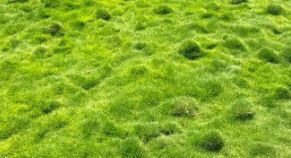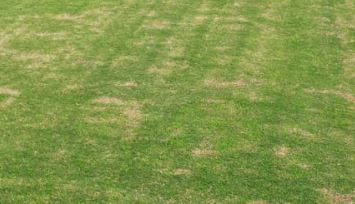Is your garden soil hard as a rock, and bumpy? Mine is. It’s disappointing. To add to that, I always seem to have neighbours with perfect gardens as well, which is frustrating. Anyway, I have decided to do something about it. I’ve looked into dealing with my rock hard soil and bumpy garden situation and found out some interesting stuff.
How to deal with rock hard soil and a bumpy lawn? The hard soil needs to be aerated with a garden fork and mixed in with some sand to improve drainage. Bumpy lawns can be fixed by removing weeds, aerating bumpy patches with a fork, and applying topsoil annually.
But why does garden soil get hard, and bumpy? Your garden soil being rock hard is due to your soil having a high clay content or a lack of oxygen content. Your lawn being bumpy can be due to a few factors including heavy traffic, weeds, and the ground freezing & thawing. Thankfully there are a few things you can do to fix these issues and good garden habits you can adopt to stop it from happening again.
Dealing with rock hard soil- Deal with it in a section at a time

Looking at the area of rock hard soil, possibly overgrown with weeds can put you off dealing with it in the first place. As with a lot of things dealing with the problem in bite-size chunks usually helps. It worked for me anyway.
If your soil is particularly hard, I’d suggest using a shovel or a spade to begin with, as it’s easier to break up the soil.
- Break the length or area of soil that needs dealing with into 6-8 sections
- Start digging a hole, removing the soil and building a mound on the section that you’re going to work on next.
- Remove any weeds using secateurs, or by pulling them out.
- Then break up the soil with a fork, mix in some sand and compost and return it
- Move to the next section and repeat
Digging up the ground in this logical way will just allow you to get the job done faster.
You might be thinking, what kind of sand should you be using to aerate your soil? Good question. I went for Westland Lawn Sand. I used about 80 grams per square meter. It has some other ingredients including a nitrogen-based fertilizer, which is good if you’re planning on planting anything. If you have any pebbles or small rocks, mix these in too, its extra drainage.
The immediate results are great, look at mine before and after.
Unfortunately, you can’t just stop there. If you leave it, you’ll be in the same position next year. I’ve found a pretty good gardening schedule, that you might find useful later in this article too.
Before we get into that let’s take a look at bumpy lawn issues.
How to deal with a Bumpy Lawn

Bumpy lawns can be a result of a few things including freezing and thawing as well as heavy traffic in your garden as already mentioned.
If you have a bumpy lawn, the following observations are pretty common
- Bare Patches – Usually due to poor weather conditions, larget dry spells followed by prolonged wet spells.
- Patches of yellowing – the pre-cursor to a bare patch of grass, or a result of high spots of grass cut too low by your mower
- Hollows – caused by heavy rain, but due to poor preparation when your lawn was initially laid.
- Cracks in your lawn – This is due to a lack of water. It’s also a symptom of a heavily compacted lawn too.
My lawn had all of these issues, but it’s time to deal with it (Cue the garden renovation music of your choice).
A renovation programme for your neglected lawn.

Whether you’ve inherited a neglected lawn, or whether you abandoned your lawn, it’s time to stop pointing fingers. Take these steps to fix your lawn, and then we’ll look at how we can stop it from happening again. I’m a left my lawn high and dry too, literally. The point being, we’re in this together.
Steps to renovate your lawn
- Examine the damage in Early Spring
- Cut down the tall grass and weeds
- Re-examine the lawn surface
- Rake and brush the surface
- Mow your lawn on a high setting
- Time to feed and weed, then leave for Summer
- Get the last of the weeds in early Autumn
- Carry out lawn repairs – Job done!
Here’s a bit more detail to help you on your way. You should aim to start this process at the beginning of spring, so around March-April time.
1. Examine the Damage
Carefully look through the grassand weeds. If moss and other weeds almost completely dominate your lawn area, then the best plan at this stage may be to consider starting again and getting your garden re-turfed.
Hopefully the majority of your lawn is made up of lawn grass (most peoples are). As long as it is, you can carry on through these steps.
2. Cut down the tall grass and weeds
You may need to use a large mower depending on how tall the grass and weeds are. You want to cut about 3 inches off the ground if you do this
3. Re-examine the lawn surface
At this stage, you’ll want to make a list of lawn issues, and can be anything. It’s helpful to track your issues. As an example here’s my list of lawn issues
- Weeds
- Bumps & Hollows
- Brown Patches
- Bare Patches
- Yellow Patches
- Ant Hills
- Daises
4. Rake and Brush the surface
It’s important to rake so that any cuttings, dead vegetation and rubbish are removed.
5. Mowing over next few weeks
Use your lawnmower to cut down your grass, progressively lower each week. The maximum height you should cut down to is about 0.5 inches. Any lower than that and the strength of the grass is significantly reduced.
6. Feed and weed the lawn
Any lawn feed products that you use should be used now in early summer. If you have moss growing, it’s a good time to apply these products too
7. Get the last of the weeds in early Autumn
Take another look at your lawn, apply some Autumn lawn feed and pull out any weeds that may have re-surfaced.
8. Carry out lawn repairs -Job done!
Ok, so now its time to attack patches, yellow sports, bumps and hollows in your law. This step should be taken immediatly after step 7.
How to deal with Bumps & Bare Patches
You can try rolling out the bumps with garden roller if you have one. If you don’t have one like me, the best thing to do is to carry out some garden surgery.
- Remove the dead patch of turf in a square
- loosen the soil with a hand fork
- Buy some turf of take for another area of the garden and place in the square

Alternatively, you could put down some grass seeds along with some topsoil instead of turf if you wish. You should look to water your patches of grass every other day if there is no rainfall for two months at this point.
How to deal with Hollows
Hollows are small dips or depressions in your lawn, that tend to drain more slowly than the rest of your lawn. The grass looks greener and lusher. You essentially want to add soil under the depressed area to bring the ground up.
- Cut the garden turf area where the hollow area is and peel back the turf edges
- Add soil underneath and put the turf back.
- Use a piece of wood to press down the turf, but not too hard and make sure it’s level with the rest of the grass

Water every other day for 2 months if there’s no rainfall, and that’s it!. You have set the foundations of a great lawn in the future!
Lawn Maintenance – Your very own lawn calendar month by month
So you’ve done all the work correcting your lawn. You can’t leave it there unfortunately. The thing with weeds, and grass is that everything will grow back if left. The good news is that maintaining your lawn is much easier than doing all of the lawn repair work again.
| Month | Lawn Activity |
| January | No work required |
| February | A good month to re-turf if you intend to, otherwise no work required |
| March | Carry out your first cut of the lawn. Cut the lawn at a high setting, at around 1.75 inches. Closer cutting may result in yellowing in march. This is a good month to look for early signs of moss, and you can apply moss killer as necessary. If you have any patching issues or bumps, this is a good time to address them as well |
| April | April is a good month to inspect your grass for any weeds which you can pull out. It’s a good time to apply lawn feed as necessary too. |
| May | This month, start moving your grass once a week. Because your lawn grows faster you can cut it shorter to about 1.25 inches. |
| June | Apply Summer Lawnfeed this month and cut your grass once every two weeks. As the weather is dryer you shouldn’t need to cut it every week |
| July | This is a good month to use your weedkiller if there are any present in your lawn given the dry weather. |
| August | The same general treatment as for July. As this is the last summer month, this should be the last month that you apply any weed killer on the grass |
| September | It’s time to raise the height of the level of lawn that you cut here. You can apply lawn feed in this month if you wish. You can also repair any patches or hollows as necessary too. |
| October | Regular mowing should come to an end this month. The focus should be only picking up fallen leaves and fruit leaving the lawn as clear as possible. |
| November | Continue to keep the lawn clear of leaves. No further work required |
| December | No further work required |
Key tasks that you need to stay of top of for a great lawn, include the following:
- Mowing regularly
- If the weather is dry for prolonged period of time – water the grass before it turns brown
- Keep on top of your garden edges, keep it looking neat
- Apply lawn feed at regular seasonal intervals, to keep the nutrients in the soil
- Kill weeds and moss as soon as it appear, by pulling out and applying weed killer
How often should I aerate the lawn?
If your lawn is subject to a lot of traffic with barbecues or with kids playing, for instance, you should aerate your lawn once every 2-3 years.
You can aerate the lawn by driving a fork or other spiked instrument in your lawn at various intervals. The reason you do this is to relieve the lawn of compaction and improve drainage. It keeps your lawn feeling light and fluffy.
Is it possible to revive dead grass?
If your grass is completely dead due to a prolonged dry spell, it’s unlikely that you’re going to revive it. IF your lawn is brown though, you can definitely but your grass back on a path to green.
Regular watering over 3-4 weeks should get your grass looking green again. During dry spells, grass can lose 4.5 gallons of water per week, so it’s important to get ahead of the game and water your lawn during hot spells.
Making your grass as drought resistant as possible will help this from happening in the first place. Activities include:
- Spiking the turf at least once every three years to keep the lawn aerated
- Leaving the lawn length higher that 0.5 inches whenever you cut it
- Feeding the lawn regularly with lawn feed
Want more information?
Whether you came to this article looking for an answer to your question about rock hard soil or your lawn, I hope I’ve helped you. If I haven’t I thought I’d highlight some useful posts on gardening in general that helped me treat my lawn.
Lovethegarden has a great post on garden drainage, and some handy tips for beginners to manage the drainage and waterlogging in your garden.
Wikihow is great for illustrative examples of well anything. This guide is how to garden with illustrative pictures. It also includes where to plan your plot as well!
Pennington.com shares some great advice in this post about getting your lawn just perfect. So if you have graduated from getting your lawn for a bad state to an average state, this post is for you.
In Summary…
Sorting you garden out properly once is a useful exercise, and once done it doesn’t require too much maintenance to keep it up.
Once have filled in your hollows or bumpy patches in your garden and straighten it up as well as getting your soil nice and straight you’re all set to show off to the neighbours.
Using these tips (most of which I found doing my own research) has really made a difference to the approach I have taken.
Whether I’m doing something in my home, like wallpapering or garden, I try and approach everything in bitesize chunks.
That way the task isn’t too daunting. That’s the intention of this article.

